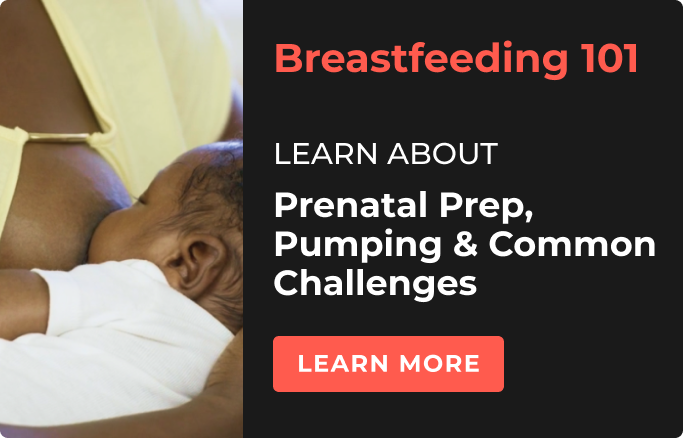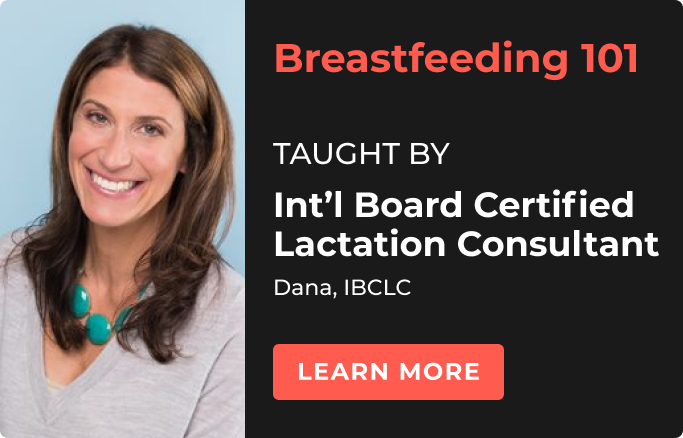In this Ask an Expert, we ask Dana C., professional IBCLC and instructor for our Breastfeeding 101 course, exactly how often a breastfeeding parent should pump. Don’t forget to check out our FREE breastfeeding course, to prepare you or help you on your breastfeeding journey.
Question: How often should I pump?
Answer: How frequently you should pump and when you should start pumping depends on what your breastfeeding situation is and what your breastfeeding goals are. Below we’ll walk you through some typical scenarios and provide some general recommendations. If you don’t fit neatly into one of these categories, or you have additional questions, reach out to a certified lactation consultant for more individualized guidance.
How often should I pump if latching and nursing are going well from the start, and there is no immediate need for a bottle?
Quick answer: Wait 2-4 weeks after birth and then consider pumping 1-2 times a day.
Rationale: If your baby is latching well from birth, nursing 8-12 times a day, and there are no concerns about your milk production or baby’s weight then just stick to nursing for the first few weeks. Take the first 2-4 weeks postpartum to settle into your new role and your new routines. There is no need to rush into pumping. Instead, allow yourself this time to perfect a comfortable latch, enable the baby to regulate your milk supply to their needs, and build your nursing confidence. Once the baby is back to birth weight (usually by their 2 week check-up at the pediatrician) and any initial engorgement discomfort you may have experienced has subsided, it may be a good time to start pumping. One popular strategy is to add in a pump session immediately following a nursing session. Usually a morning session is best since you have the most milk in the AM, you will likely get the most output. So, do a normal breastfeeding session and then pump for about 15-20 minutes. Whatever milk you collect is “bonus milk” you can store and then when baby is ready to nurse a few hours later, your breasts will be full again. You’ll also want to pump whenever you give baby a bottle - essentially, you swap a nursing session for a pump/bottle session.
How often should I pump if baby is losing weight and milk production seems low?
Quick answer: Pump in addition to nursing 2-8 times a day to help initiate/build milk production; pump for 10-20 minutes depending on how well the baby nursed. If the baby nursed for a long time, such as 30-40 minutes, a 10 minute pump should be sufficient. Your baby’s doctor may also have you supplement the baby with expressed breast milk or formula as needed.
Rationale: The more frequently and effectively you stimulate/empty your breasts, the more milk your body will make (e.g., the more you demand of breasts, the more breasts will supply) therefore adding in pumping sessions is an effective strategy to increase milk production. However, nursing and pumping around the clock can become very burdensome for the breastfeeding parent, so usually lactation professionals don’t recommend this as a long term solution.
How often should I pump if I am separated from my baby after birth? (e.g., baby is in the NICU):
Quick answer: Pump every 3 hours for 15 to 20 minutes (this mimics what baby would be doing if you were together to initiate/build a strong milk supply).
Rationale: If baby can’t go to the breast after birth, research shows that it’s best to begin pumping as soon as possible. Hand expression is often the easiest/most logistically appropriate way to begin. Then, initiate electric breast pump use soon thereafter -- within 4-6 hours is best. For the first few days postpartum, the best recommendation is to pump for 15-20 minutes every 3 hours and then do a few minutes of hand expression afterwards. Research shows combining hand expression with electric breast pumping can increase milk production tremendously.
How often should I pump when I go back to work?
Quick answer: While at work, pump close to the same frequency as baby is eating.
Rationale: Ideally, you want to pump around the same time/frequency as baby is eating while you are apart. This pumping schedule protects your milk supply, ensures your breasts remain comfortable at work, and hopefully collects enough milk for future bottles.
A few general pumping tips no matter how often you pump:
- Pumping shouldn’t hurt
- Ensure breast shields are the correct size (we help you determine this in our class!)
- Don’t crank the pump all the way up! Set the suction at the highest, but still comfortable, setting.
- Ensure you center your nipples in the flange tunnel
- Lubricating the tunnel of the flange can help enhance comfort
For more pumping and breastfeeding tips, don’t forget to check out our FREE Breastfeeding 101 course. We’ll share everything you need to know for successful pumping and breastfeeding including more tips for how often to pump, comfortable and effective pumping, how to increase your milk supply, how to safely store your milk, troubleshoot some of the most common pumping issues, and more.




